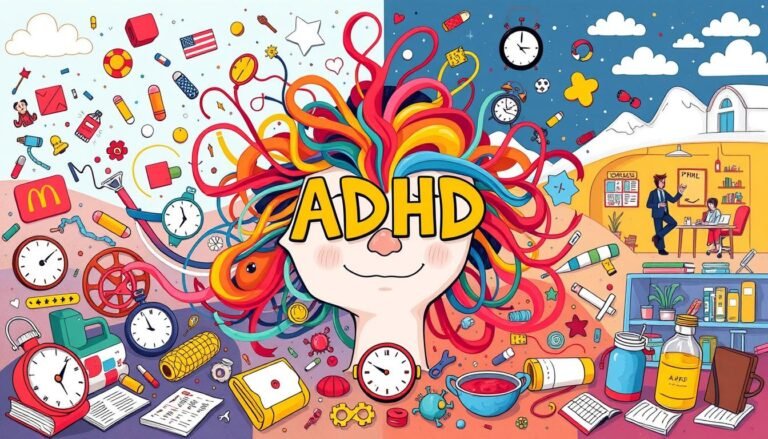Exploring Positive Psychology Theory: Key Insights
Have you ever thought about why some people do well even when things get tough? This is at the core of Positive Psychology Theory. It has changed how we see well-being and growing as individuals.
Positive Psychology Theory was started by Martin Seligman. It moves away from just treating mental illness. Instead, it focuses on building human strengths and potential. This field has been around for over 30 years, looking into what makes life fulfilling and optimal.
Unlike old-school psychology, which often looks at what’s wrong, Positive Psychology Theory values positive experiences. It looks at both inside and outside factors that boost well-being and optimism.
Studies in this area have uncovered new ways to thrive. The PERMA model and learned optimism are just a few examples. These ideas give us tools for growing personally and staying strong.
As we dive into Positive Psychology Theory, we’ll see how it helps people live meaningful lives. We’ll learn how to reach our highest potential.
The Origins and Development of Positive Psychology
Positive psychology started in the late 20th century. It combines ancient wisdom with modern research. This field focuses on human strengths and well-being, not just problems.
Martin Seligman’s Inspiration and Vision
Martin Seligman is a key figure in positive psychology. He wanted to explore how people can thrive, not just deal with illness. His work on resilience and optimism helped shape the field.
Shifting Focus from Pathology to Well-being
Positive psychology is meant to add to traditional psychology, not replace it. It looks at what makes life fulfilling, like happiness and personal growth. Studies show most people are happy and can bounce back from tough times.
The Positive Psychology Manifesto
In 2000, Seligman and others published a manifesto in American Psychologist. It outlined the core of positive psychology. They highlighted the need to study positive emotions and strengths.
| Key Concepts | Benefits |
|---|---|
| Well-being | Improved life satisfaction |
| Resilience | Better coping with adversity |
| Mindfulness | Enhanced emotional regulation |
| Character Strengths | Increased personal growth |
Positive psychology uses science to understand how people flourish. It draws from philosophy, neuroscience, and social psychology. This helps us understand well-being and resilience better.
Core Principles of Positive Psychology Theory
Positive psychology focuses on building strengths, not fixing weaknesses. It believes in our natural ability to grow and thrive. It highlights the role of positive emotions, engagement, and meaningful relationships in achieving happiness.
The PERMA model is a key part of this theory. It lists five elements for a fulfilling life: Positive Emotion, Engagement, Relationships, Meaning, and Accomplishment. Studies show that well-being leads to better work, stronger bonds, and better health.
The Values in Action (VIA) Survey has been taken by over eleven million people. It helps find your character strengths. This tool is used in many areas to help grow personally and professionally.
“Happiness equals genetic set point plus life circumstances plus factors under voluntary control.” – Martin Seligman
Positive psychology also talks about positive deviance. It’s about finding solutions by looking at what works well. This approach helps move from struggling to thriving.
Learning about these principles can make us more optimistic and resilient. As positive psychology grows, it gives us valuable lessons for a better life and society.
The PERMA Model: A Framework for Well-being
The PERMA Model was created by Martin Seligman. It’s a detailed way to understand well-being. This model has become a big part of positive psychology, making up 4% of all psychology studies.
Positive Emotions
Positive Emotions are at the heart of the PERMA Model. They add to our happiness and life satisfaction. Studies show that positive emotions can fight seasonal affective disorder, which affects 6% of the UK in winter.
Engagement
Engagement means being fully into what we do. It’s about finding flow and purpose in our daily tasks. Research shows it can lower mental distress, which rose by 8.1% in April 2020.
Relationships
Good social connections are key for well-being. The PERMA Model stresses the need to build strong relationships. This is especially true for college students, as 63.1% felt lonely in 2017.
Meaning
Finding meaning and purpose is crucial for lasting satisfaction. Even though meaning had the lowest factor loading (0.25), it’s still a vital part of well-being.
Accomplishment
Setting and reaching goals gives us a sense of accomplishment. This part of the PERMA Model had the highest factor loading (0.76), showing its importance in well-being.
| PERMA Element | Factor Loading | Significance |
|---|---|---|
| Accomplishment | 0.76 | p |
| Positive Emotions | 0.54 | p |
| Relationships | 0.48 | p |
| Engagement | 0.39 | p |
| Meaning | 0.25 | p |
The PERMA Model offers a valuable way to improve well-being. By focusing on these five areas, we can aim for a more balanced and fulfilling life.
Character Strengths and Virtues in Positive Psychology
Positive psychology looks at Character Strengths as a key part of well-being. The VIA Classification has changed how we see human virtues and strengths.
The VIA Classification of Strengths
The VIA Classification came from a three-year study with 55 top social scientists. It found 24 character strengths, sorted into six main virtues:
- Wisdom
- Courage
- Humanity
- Justice
- Temperance
- Transcendence
These strengths include traits like curiosity, kindness, bravery, and gratitude. The VIA Inventory of Strengths helps people find their unique strengths.
Applying Character Strengths in Daily Life
Using character strengths every day can really help with Personal Growth. Research shows that using your top strengths in new ways weekly boosts happiness and lowers depression. This method works well in many areas, like improving job performance and school success.
Character strengths also help with health and well-being. Programs that build these strengths have shown great results. They help people with chronic illnesses feel better mentally.
| Application Area | Benefit |
|---|---|
| Work | Improved job performance |
| Education | Enhanced academic success |
| Health | Better psychological well-being |
| Personal Life | Increased happiness, decreased depression |
By knowing and using their character strengths, people can handle life’s challenges better. They can find more joy and success in their personal and work lives.
Authentic Happiness Theory: Redefining Well-being
Martin Seligman’s Authentic Happiness Theory changed how we see well-being. It says true happiness comes from living a meaningful life, not just seeking pleasure. The theory focuses on three main points: finding your strengths, doing activities that make you flow, and building strong relationships.
Seligman’s work moved us from seeing happiness as a goal to seeing it as a result of living with purpose. This idea has led to many efforts to focus on strengths and positive emotions. The Authentic Happiness Theory fits well with Positive Psychology, which started in the late 1990s.
Positive Psychology is becoming more popular worldwide. In Brazil, for example, it has grown a lot since 2000. A key event was a meeting in Florianópolis in 2006. It sparked a lot of interest in Positive Psychology among Brazilian researchers.
| Aspect | Traditional Psychology | Authentic Happiness Theory |
|---|---|---|
| Focus | Mental illness, disorders | Well-being, strengths |
| Goal | Reducing negative symptoms | Enhancing positive experiences |
| Approach | Problem-centered | Strengths-based living |
The Authentic Happiness Theory keeps growing, showing how Positive Psychology is always changing. As we learn more, it will help us understand how to find lasting happiness and fulfillment.
Resilience and Learned Optimism
Resilience and learned optimism are big in positive psychology. They help us get through hard times and see the bright side. Let’s see how these tools can make our lives better.
Overcoming Learned Helplessness
Learned helplessness makes us feel trapped. But, there’s hope! Optimists live longer and face less mental health issues. By changing our thoughts, we can break free and think more positively.
Cognitive-Behavioral Techniques for Resilience
Cognitive-behavioral techniques boost resilience. They help us change negative thoughts and think more optimistically. Optimists are healthier and handle stress better. These methods help us see challenges in a positive light.
Post-Traumatic Growth
Post-traumatic growth is amazing. It shows how we can grow stronger after hard times. Optimists see bad times as short-lived and learn from failures. They always look to improve. By seeing hardships as chances to grow, we can develop personally.
Source Links
- Advancing the Study of Positive Psychology: The Use of a Multifaceted Structure of Mindfulness for Development
- Martin Seligman’s Contributions to Positive Psychology: A Comprehensive Overview
- The Roots and Rise of Positive Psychology: From Aristotle to Seligman
- 12.1 The History of Positive Psychology
- Martin Seligman and the Rise of Positive Psychology
- Five Key Principles of Positive Psychology – Langley Group
- PERMA™ Theory of Well-Being and PERMA™ Workshops
- PERMA+4: A Framework for Work-Related Wellbeing, Performance and Positive Organizational Psychology 2.0
- Application of the PERMA Model of Well-being in Undergraduate Students
- Character Strengths, Character Virtues Handbook
- Making Sense of Character Strengths
- From authentic happiness to well-being: the flourishing of Positive Psychology
- Redalyc.From Authentic Happiness to Well-Being: The Flourishing of Positive Psychology
- How Learned Optimism Can Improve Your Life
- Practicing Learned Optimism
- Positive Psychology 101: Core Principles & Life-Changing Benefits








